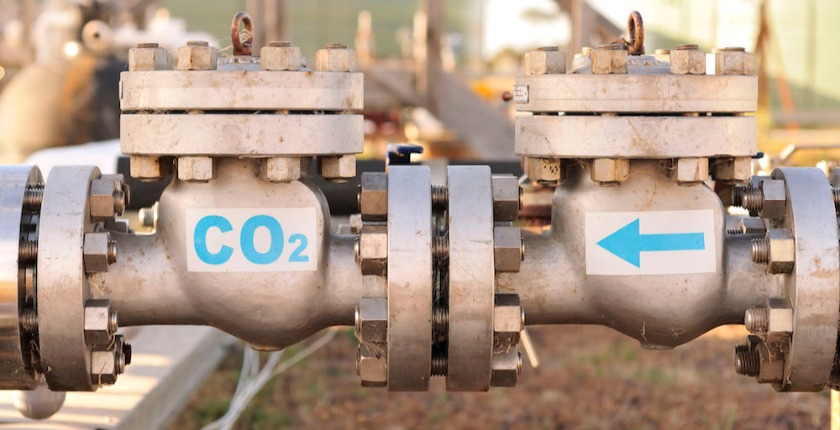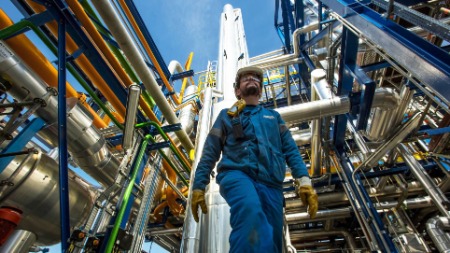Interviews - May 17, 2019
What’s the future for Carbon Capture and Storage? Interview with Brad Page, CEO of Global CCS Institute


Written by Tristan Lebleu 7 min read
Could we deal with our carbon emissions challenge by capturing them from industrial facilities or directly from the atmosphere?
Carbon Capture and Storage (CCS) has gained much attention since the IPCC made it a critical technology to avoid significant global warming in their Special Report on Global Warming of 1.5°C. While critics consider CCS could slow the clean energy transition, many consider it an indispensable solution.
Brad Page, CEO of the Global CCS Institute, explains why he is convinced these technologies can play a major role to avoid the catastrophic consequences of climate change.
Can you explain briefly what is carbon capture and storage? How long has it been around and why has it gained much attention recently?
Carbon capture and storage, also known by the acronym CCS, is a set of technologies that prevent CO2 emissions from entering the atmosphere by storing them safely deep underground in dedicated geological formations. This emission abatement technology captures CO2 from large-scale emissions processes– such as industrial facilities like steel and cement factories, natural gas processing or power plants – or removes CO2 directly from the atmosphere.
When stored deep underground, the CO2 remains trapped in the pores of the rocks. This technology is essentially replicating a natural process that has trapped natural resources such as oil and gas underground for millions of years. It is important to highlight that CCS is not a new or futuristic technology. It is a proven and safe technology that has been in commercial operation since the 1970s.
CCS is a versatile technology that can support global efforts to tackle climate change and decarbonise our economies. First, CCS is a powerful CO2 abatement option for industrial emissions and power generation. CCS can support the decarbonisation of energy-intensive industries including steel, cement, fertilisers and petrochemicals as well as of the electricity system. It enables the supply of clean hydrogen to fuel transport, heating and industrial processes. Finally, CCS can also be an enabler of negative emissions through bio-energy with CCS (BECCS) and direct air capture.
For decades, CCS has been advanced as a potential climate mitigation option. Recently, the technology emerged as the critical technology to avoid significant global warming with the release of the Intergovernmental Panel on Climate Change (IPCC) Special Report on Global Warming of 1.5°C last October. The landmark report revealed the disastrous consequences of reaching 2°C, calling for unprecedented action to limit warming to 1.5°C. In the report, three of the four scenarios includes CCS as an important climate mitigation technology to compensate for remaining emissions and significantly reduce emissions.
According to the IEA’s Sustainable Development Scenario, at least 7% of cumulative emissions reductions are expected to come from CCS; requiring some 2,000 individual CCS facilities by 2040.
Is there an opposition between the deployment of renewable energy and CCS technology?
For too long, too many people and organisations have positioned renewables and CCS in opposition to each other. They are complementary and working towards the same objective, which is the decarbonisation of the global economy. We do not see CCS as a silver bullet. No technology can get the job done on its own. All solutions and mitigation options are necessary to tackle the decarbonisation challenge and deliver a sustainable and cost-effective energy transition. The transformation of our energy system is a complex and challenging task. It is not helpful to pit technologies against each other. This endangers losing sight of what we need to achieve in a relatively short period - the next 10 to 15 years.
Exponential renewables scale-up is a must. There is also a pressing need to eliminate emissions from heavy industry, power generation and transportation. To achieve this, a portfolio of technologies and measures will be needed to reach the Paris targets, and this includes CCS. The technology can also complement renewables to further integrate them into the grid by providing firm and dispatchable carbon-free electricity generation capacity.
Hydrogen is the next big at-scale development that will accelerate decarbonisation efforts. Creating hydrogen from gas and coal with CCS is the lowest cost route to decarbonised hydrogen in many parts of the world. CCS can provide an accelerated platform to support still broader hydrogen production options including through the use of renewables for electrolysis.
And it is important to recognise that the renewable energy transition will also lead to an increase in the demand for steel, cement and other products, whose lifecycle emissions can be reduced with CCS.
What is the current state of development of this technology?
CCS facilities are operating in several countries around the world including Norway, China, Canada, United States, Japan and the United Arab Emirates. The first CCS project was established back in the 70s in the United States. Today, there are 43 large-scale CCS facilities around the world – 18 in commercial operation, five under construction and 20 in different stages of development. These facilities cover a wide range of industries and sectors including chemical and hydrogen production, iron and steel, natural gas processing, power generation, fertiliser and ethanol production.
In Europe, there are promising projects in advanced phases of development including the PORTHOS project in the Netherlands aiming to decarbonise industry in Europe’s largest port in the Rotterdam area. Another exciting development is the H21 North of England project aiming to decarbonise 3.7 million UK homes and businesses by converting the gas grid to hydrogen produced from gas with CCS. In Norway, the government has the ambition to bring a full-scale CCS project capturing emissions from two industrial sites (cement and waste-to-energy plant) and developing open access CO2 transport and storage that will be accessible to other industrial emitters across Europe.
These projects can support global efforts to speed up the clean energy transition. However, to deliver on the Paris targets, more than 2,000 CCS facilities will be needed by 2040. This is an ambitious scale-up and calls for stepping up the pace in CCS deployment. With this, there is the need to think beyond CO2 capture and emphasise the importance of developing common CO2 transport and storage infrastructure, that can be shared through open access by a number of industrial emitters as well as utilised by direct air capture facilities to enable negative emissions.
What are the main barriers the deployment of CCS technology?
Costs of CCS technology and security of storage are usually mentioned among the perceived barriers to CCS deployment.
In the context of the cost discussion, it is crucial to consider the value and potential of CCS to the wider energy system and its role in processing CO2 emissions and significantly reducing them. The costs of CCS vary significantly depending on industries and processes. It can be $100 per tonne of CO2 or as low as $20 a tonne for applications such as ethanol production. This depends on the purity of the CO2 stream and infrastructure available. But what we do know is that like the experience we had with renewables, CCS costs will continue to fall as more facilities come online and we learn from those experiences.
CCS, like any other technology, requires a supportive policy framework. At the moment, there are several existing gaps that are preventing investment in CCS. This starts with the lack of a sufficient value on carbon to offer an incentive for emission reductions. Governments also must play a role in securing and developing relevant CO2 transport and storage infrastructure.
Finally, many will also refer to the risk of CO2 leakage. However, existing projects, industry expertise and scientific literature have demonstrated that this is not a concern. According to a recent scientific paper, 98% of the injected CO2 remains permanently trapped in the subsurface. The IPCC also found that for well-selected, managed and designed geological storage sites; it is estimated that 99% of the CO2 will be retained for millions of years.
Why is there some defiance and criticism towards CCS?
Like any other technology, CCS has received its share of criticism often based on unfounded information, misconceptions and myths. Many continue to say CCS is unproven and too expensive. As I explained earlier, this is not true. CCS can be an important technology to abate emissions from a variety of sources. With this in mind, there should be no unabated sources of fossil fuels. The value of CCS should be reflected by the potential of the technology to provide deep decarbonisation and a supply of clean energy, in cases CCS enables a net-negative carbon footprint.
There are also those groups that contend that CCS will simply enable the fossil fuel industry to maintain business as usual. We think this not borne out by the current state and trajectory of the energy transition. In fact, CCS is necessary to at least address the emissions of the hard to abate sectors and in some parts of the world will be necessary to abate the emissions from very young coal and gas-burning generators.
What is the political consensus around CCS? Do you see currently more support or opposition from politicians on this technology?
This varies among the political factions and follows current climate and energy discussions taking place in different countries. However, one thing is clear: CCS is very much back in the climate and energy policy agenda given the challenge to deliver the 1.5°C and net-zero by the second half the century.
In Europe over the past year, there has been increased recognition among different circles that CCS will have a role to play in pursing efforts to keeping the global temperature to 1.5°C. Last November, the European Commission released its vision for a climate neutral Europe. One of the seven building blocks of this strategy is CCS which is seen as a vital technology to deliver a net-zero emissions economy. Following the release of the Strategy, we have also seen support for CCS at the European Parliament in different adopted resolutions highlighting its role in mitigating emissions in certain industries.
Another example is Norway where the government is fully supportive of CCS and has the ambition to deploy a large-scale CCS project in 2023/2024. The UK government and its Energy and Clean Growth Minister Claire Perry also fully recognise the potential of CCS to create significant value for the country and aim to deploy the first CCUS facility in the UK in the mid-2020s.
Turning to the United States, the conversation around CCS is also booming and the technology enjoys broad political support from not just across both parties, but also environmental groups. A tax credit—also known as 45Q—which was passed last year is currently the highest CCS-specific incentive globally.
What kind of policies are needed to fast-track its deployment?
There are several ways that policy can support and spur the large-scale deployment of CCS starting with establishing a value on carbon to create a financial incentive for investing in CCS. Governments can also play a role by enabling the development of shared CO2 transport and storage infrastructure which is key to accelerate the deployment of the technology. The Institute recently published a report that puts forward key recommendations for policymakers on how to create a favourable and enabling policy environment for CCS.
What is the economic opportunity of CCS in terms of market growth and job creation?
CCS can bring significant opportunities to economies and societies globally by retaining jobs, creating new industries, decarbonising existing products and creating new low-carbon products.
In Norway, it is estimated that the development of a CCS industry would bring considerable value to the country by creating between 30,000 and 40,000 new jobs by 2030. The study also estimated that in 2050, 80,000 – 90,000 new jobs could be created in Europe following the development of this industry. In the UK, CCS is seen as an opportunity to deliver clean growth opportunities for the country and its industries.

Written by Tristan Lebleu on May 17, 2019


